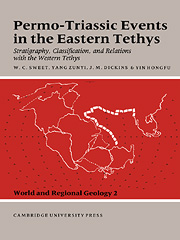 Permo-Triassic Events in the Eastern Tethys
Permo-Triassic Events in the Eastern Tethys Book contents
- Frontmatter
- Contents
- List of contributors
- Preface
- Acknowledgments
- 1 Permo-Triassic events in the eastern Tethys – an overview
- 2 Permo-Triassic boundary relations in South China
- 3 Permo-Triassic boundary of the Indian subcontinent and its intercontinental correlation
- 4 Permo-Triassic boundary on the Indian peninsula
- 5 The Permo-Triassic boundary in the southern and eastern USSR and its international correlation
- 6 Classification and correlation of nonmarine Permo-Triassic boundary in China
- 7 Permian and Triassic events in the continental domains of Mediterranean Europe
- 8 The Permo-Triassic boundary in the Southern Alps (Italy) and in adjacent Periadratic regions
- 9 Permo-Triassic brachiopod successions and events in South China
- 10 Conodont sequences in the Upper Permian and Lower Triassic of South China and the nature of conodont faunal changes at the systemic boundary
- 11 A conodont-based high-resolution biostratigraphy for the Permo-Triassic boundary interval
- 12 The palynofloral succession and palynological events in the Permo-Triassic boundary interval in Israel
- 13 The effects of volcanism on the Permo-Triassic mass extinction in South China
- 14 Geochemical constraints on the Permo-Triassic boundary event in South China
- 15 Permo-Triassic orogenic, paleoclimatic, and eustatic events and their implications for biotic alteration
- 16 Permo-Triassic boundary in Australia and New Zealand
- Index
15 - Permo-Triassic orogenic, paleoclimatic, and eustatic events and their implications for biotic alteration
Published online by Cambridge University Press: 12 October 2009
- Frontmatter
- Contents
- List of contributors
- Preface
- Acknowledgments
- 1 Permo-Triassic events in the eastern Tethys – an overview
- 2 Permo-Triassic boundary relations in South China
- 3 Permo-Triassic boundary of the Indian subcontinent and its intercontinental correlation
- 4 Permo-Triassic boundary on the Indian peninsula
- 5 The Permo-Triassic boundary in the southern and eastern USSR and its international correlation
- 6 Classification and correlation of nonmarine Permo-Triassic boundary in China
- 7 Permian and Triassic events in the continental domains of Mediterranean Europe
- 8 The Permo-Triassic boundary in the Southern Alps (Italy) and in adjacent Periadratic regions
- 9 Permo-Triassic brachiopod successions and events in South China
- 10 Conodont sequences in the Upper Permian and Lower Triassic of South China and the nature of conodont faunal changes at the systemic boundary
- 11 A conodont-based high-resolution biostratigraphy for the Permo-Triassic boundary interval
- 12 The palynofloral succession and palynological events in the Permo-Triassic boundary interval in Israel
- 13 The effects of volcanism on the Permo-Triassic mass extinction in South China
- 14 Geochemical constraints on the Permo-Triassic boundary event in South China
- 15 Permo-Triassic orogenic, paleoclimatic, and eustatic events and their implications for biotic alteration
- 16 Permo-Triassic boundary in Australia and New Zealand
- Index
Summary
Introduction
It has long been recognized that a major change in fauna and flora was associated with a major regression in the latest Permian and earliest Triassic (see Dickins, 1983). The nature of this regression (or eustatic change) and its relationship to orogenic and tectonic developments in the Upper Paleozoic and Lower Mesozoic are discussed in this paper, which also includes comparisons with the Cretaceous–Tertiary boundary sequence. The climate of the Permo-Triassic boundary interval is also considered and its nature and influence amplified.
Volcanic rocks are widespread in Permo-Triassic boundary sequences but, as indicated elsewhere in this volume, their importance has only recently been recognized. The volcanism indicated by these rocks was related to tectonic and magmatic developments, which, together with the eustatic change and climate, must have had a profound effect on the fauna and flora of the time. These factors and apparently associated changes in the composition of seawater, the atmosphere, and the nature of the land, seem more than adequate to explain changes in the flora and fauna. The latter, in turn, are important potential guides to understanding development of the earth below the crust.
Tectonic and magmatic development
The Permo-Triassic boundary interval includes evidence of a remarkable regression, which represents a large-scale eustatic fall in sea level. Newell (1962, 1967a, 1967b, 1973) advanced strong reasons for recognizing this worldwide regression, which he thought contributed importantly to the change in life that marks the difference between the Paleozoic and Mesozoic. In the decade in which Newell's papers appeared, however, coeval worldwide transgressions and regressions were not accepted in geology, as they are today.
- Type
- Chapter
- Information
- Permo-Triassic Events in the Eastern TethysStratigraphy Classification and Relations with the Western Tethys, pp. 169 - 174Publisher: Cambridge University PressPrint publication year: 1992
- 3
- Cited by


